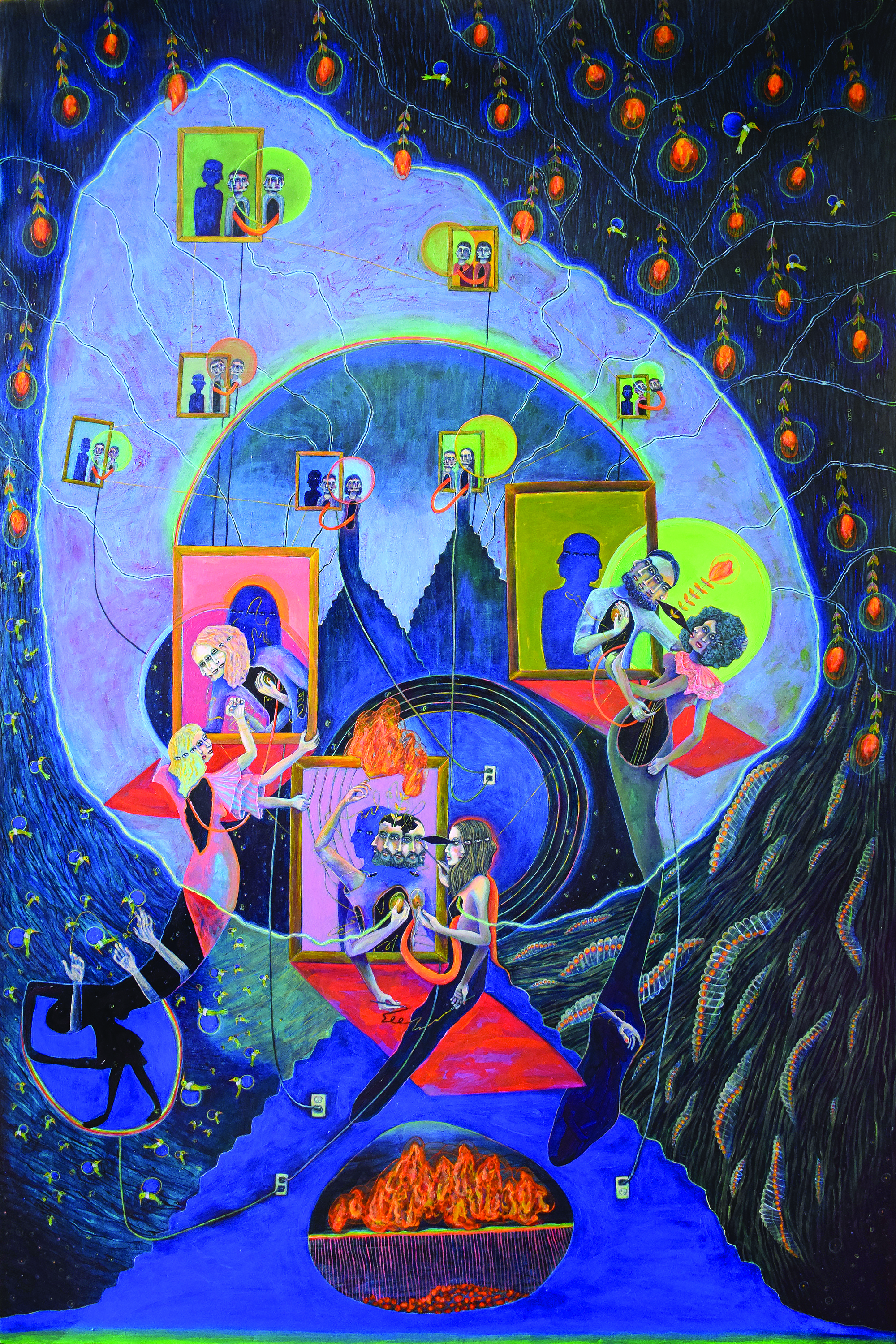

'Polyglot' by Marie Porterfield Barry
This the first time that Marie Porterfield Barry’s artwork is seen in a“From These Hills”exhibition.
“Although I grew up here, I spent my early adulthood living outside of the area and have quite recently returned. The show has a lovely cohesive quality and I think my painting fits in well with the works of the other artists. There are many works that are complex and brightly colored, and several other artists making works that address the experience of the digital.
“I grew up in Jonesville, Virginia, which was a one-stoplight small town whose name reveals its simplicity and normality. It was a lovely place to grow up in many ways as it provided vast spaces to fill with imagination. The mountains encourage a unique aesthetic as they provide an incredibly stacked view of space. If you look at my painting in the‘From These Hills’exhibition, you will see the mountain aesthetic which so regularly features in my work; the figures all look a bit like they are standing on a steep hill reminiscent of the southern Appalachians,” she says.
Her exhibit painting is called “Polyglot Longing in the Digital Age,” and it explores the ways that screens have changed our interactions with one another.
“I was thinking about the way we communicate using screens (across vast geographical spaces) but also about the way that we create ideals within these screens; digital spaces are altering the way that we experience the world and one another. We find ourselves longing for the ideals that exist within the filtered world of the screen.
“The central shape of the landscape comes from the ancient world, based on forms like the ziggurats of ancient Mesopotamia and the step pyramids of ancient Egypt; both structures served as connectors between the earth and the sky. Placing the two central figures on the top of the pyramid form was meant to place them in a position that seems transcendent. The female figure exists outside the rectangular screen-like shape; she is connected to the pyramid and to the land. The male figure is entrenched within the rectangular shape which is meant to evoke screens, but also paintings and windows, as these are all spaces into which we gaze and onto which we often impose our own concepts of the ideal. The figures that are within the rectangular screen-like spaces move in and out of the confinements of those forms.
“There are layers of metaphor within the composition from the fire inside the pyramid form which references life, longing, and desire at the core to the way that the rainbows, arcs of lightning and cords establish connections between the different spaces.
“The body of work dealing with the polyglots was inspired by the experience of speaking multiple languages. When I was living in Turkey, I became fascinated with how dramatically changing the language I was speaking influenced the way that I was perceived.
“The term polyglot literally means ‘many-tongued.’ It is such a wonderful metaphor for the experiences of people who learn to speak in a different language, or move to a new place or experience a life event that fundamentally shifts their entire reality.
“I started thinking about the concept of the polyglot more broadly and visually began to play with the idea of growing more than just a new tongue but also more eyes, more arms, more mouths, and so on. With age and experience, the world seems to increase in complexity and nuance, and I wanted figures to express that strangeness and complexity,” she says.
Barry’s work is frequently described as surrealist, but she doesn’t consider it that way. She is interested in surrealist artists, particularly Remedios Varo and Leonora Carrington. But she says that surrealist art’s focus is on the unconscious mind, which results in a connection with the imagery of dreams and memories.
Her paintings come from a “more conscious type of contemplation, more akin to poetry or philosophy. My recent works are metaphorical explorations of various human experiences, like longing, love, friendship, foreignness and motherhood. Making art is a lovely way in which to connect with other people.
“It pleases me when people enjoy looking at my paintings and even more so if the paintings spark a conversation. Throughout the history of humankind, dating all the way back to the Paleolithic era, we humans have made images of ourselves and shared them with one another. I enjoy taking part in that millennia-old visual dialogue,” she says.
Barry teaches courses in studio art and art history at East Tennessee State University and Northeast State Community College. She was the recipient of a Fulbright Grant in creative and performing arts to Turkey to study traditional Turkish tile painting. She earned a Master of Fine Arts in studio art with a concentration in painting and drawing from the University of Georgia and a Bachelor of Fine Arts in studio art with a concentration in painting from East Tennessee State University.
For more information about Barry visit www.marieporterfield.com.
There's more.